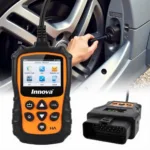Verizon telematics and OBD2 technology have revolutionized how we manage and interact with our vehicles. But how exactly do these technologies intersect, and what does it mean for you as a car owner or business operator? This guide dives into the world of Verizon telematics OBD2, exploring its capabilities, benefits, and potential drawbacks.
Understanding the Synergy of Verizon Telematics and OBD2
Before delving into the specifics, let’s clarify what these technologies entail. OBD2, short for On-Board Diagnostics, is a standardized system present in most vehicles manufactured after 1996. It acts as your vehicle’s internal communication hub, providing valuable data about its health and performance through a port usually located under the dashboard.
Verizon telematics, on the other hand, leverages the power of wireless communication to transmit this data collected by the OBD2 system. By connecting an OBD2 device, often a small dongle, to your vehicle’s port, you unlock a stream of information that can be accessed remotely via the Verizon network.
Unveiling the Benefits: Why Choose Verizon Telematics OBD2?
The fusion of Verizon telematics and OBD2 technology unlocks a plethora of benefits for both individual car owners and businesses managing fleets. Let’s break down the key advantages:
1. Real-Time Vehicle Tracking and Diagnostics
Imagine having a live feed of your vehicle’s location and performance metrics at your fingertips. Verizon telematics OBD2 empowers you with real-time vehicle tracking, allowing you to monitor its whereabouts, speed, and even fuel consumption. This feature proves invaluable for businesses tracking their fleet, parents monitoring teenage drivers, or even finding a stolen vehicle.
2. Proactive Maintenance and Reduced Downtime
No more guessing games with your car’s health. Verizon telematics OBD2 provides real-time diagnostics, alerting you to potential issues before they escalate into costly repairs. From engine performance and battery health to tire pressure and emissions, you’ll have comprehensive insights to make informed decisions about maintenance, minimizing downtime and maximizing your vehicle’s lifespan.
3. Enhanced Safety and Security
Safety takes center stage with Verizon telematics OBD2. Features like geofencing allow you to set virtual boundaries, receiving alerts if your vehicle enters or exits specific zones. This proves especially beneficial for businesses managing fleet operations or parents ensuring their young driver’s safety. Additionally, some Verizon telematics OBD2 solutions offer crash detection and emergency assistance, providing a crucial safety net on the road.
4. Improved Driver Behavior and Fuel Efficiency
For businesses, understanding driver behavior is paramount. Verizon telematics OBD2 solutions offer driver behavior monitoring, tracking metrics like speeding, harsh braking, and rapid acceleration. These insights not only promote safer driving habits but also contribute to fuel efficiency, reducing operational costs in the long run.
Weighing the Considerations: Potential Drawbacks
While Verizon telematics OBD2 offers numerous advantages, it’s essential to consider potential drawbacks:
- Privacy Concerns: The constant data stream, including location tracking, might raise privacy concerns for some users. It’s crucial to choose a reputable provider with robust data encryption and privacy policies.
- Subscription Costs: Most Verizon telematics OBD2 solutions come with monthly or annual subscription fees, which can vary depending on the features and services included. Evaluating your needs and budget is essential before committing.
- Device Compatibility: While most modern vehicles support OBD2, certain older models might not be compatible with Verizon telematics devices. Checking for compatibility beforehand is crucial.
Frequently Asked Questions about Verizon Telematics OBD2
1. Do I need a special OBD2 scanner for Verizon telematics?
No, you don’t need a separate OBD2 scanner. Verizon telematics typically involves a dedicated device, often a dongle, that plugs directly into your vehicle’s OBD2 port. This device communicates with the Verizon network, transmitting data without the need for an external scanner.
2. Can Verizon telematics OBD2 drain my car battery?
Verizon telematics OBD2 devices are designed for low power consumption and generally don’t drain your car battery. However, if you leave your vehicle unused for extended periods, it’s a good practice to unplug the device to prevent any potential battery drain.
3. Is Verizon telematics OBD2 compatible with all car insurance companies?
Not all car insurance companies offer discounts or programs that integrate with Verizon telematics OBD2 data. It’s best to contact your insurance provider directly to inquire about their specific policies and potential benefits.
4. Can I use Verizon telematics OBD2 if I switch cellular carriers?
Verizon telematics relies on the Verizon network for data transmission. If you switch to a different cellular carrier, your Verizon telematics device will no longer function. You would need to explore compatible solutions offered by your new carrier.
5. Can Verizon telematics OBD2 be used for personal vehicles and fleets?
Yes, Verizon telematics OBD2 solutions cater to both personal and fleet applications. They offer valuable features for individual car owners, such as vehicle tracking, diagnostics, and safety alerts, as well as comprehensive fleet management tools for businesses.
Exploring Further: Additional Resources
For more information on related topics, check out these resources:
Need Help Choosing the Right OBD2 Solution?
Finding the ideal OBD2 solution for your needs can be daunting. Our team of experts is here to guide you through the options. Contact us via WhatsApp at +1(641)206-8880 or email us at [email protected]. We’re available 24/7 to answer your questions and help you make the best choice.


